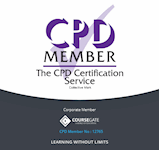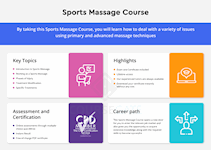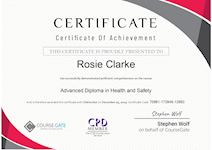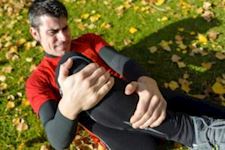Sports Massage Course - CPD Accredited
Exam Included . CPD Accredited Qualification . Lifetime access . Immediate Result
Course Gate
Summary
- Exam(s) / assessment(s) is included in price
- Tutor is available to students
Overview
Sports Massage Course is suitable for anyone aspiring to or already working in this field or simply want to learn deeper into sports Massage Course.
To make this Sports Massage course more accessible for you, we have designed it for both part-time and full-time students. This Sports Massage course is packed into the bite-size module for your convenience. You can study at your own pace or become accredited within hours!
If you require support, our experienced tutors are always available to help you throughout the comprehensive syllabus of this Sports Massage course and answer all your queries through email.
If you want to be a qualified sports massage therapist and work with professional sports figures, novice athletes or absolute beginners, then you undoubtedly have a look at this Sports Massage Course.
By taking this Sports Massage Course, you will learn how to deal with a variety of issues using primary and advanced massage techniques. You will learn how to condition Athletes muscles earlier to sporting events and help their bodies to heal after exhausting exercise as well as athletic performances. This Sports Massage course provides a comprehensive opportunity to learn diverse massage skills and fundamental tools for first aid and approaches to market your massage business.
Learning Objectives
The primary learning objectives of the Sports Massage Course are to:
- Provide a broad introduction to sports massage, including a greater understanding of the anatomy of the body.
- Refine your capabilities and skills to identify and address a diverse array of physical problems common to personal exercise, especially competitive activities.
- Train you on how to prepare your clients for their best performance, reduce fatigue, and relieve any muscle swelling and tension.
- Share simple yet very effective sports massage techniques that deepen your ability to diagnose, adjust and soothe anybody by applying strokes.
- Develop your understanding of the use of therapeutic modalities for improving muscle flexibility, which reduces and prevents injury.
- Offer expert training to help you earn your certification, increase your employment opportunities and gain the skills needed to become a Certified Sports Massage Therapist.
CPD
Course media
Description
What will you learn in this Sports Massage Course
Module 1
This module will teach you about Introduction to Sports Massage.
The field of sports massage therapy is a very popular specialization within our profession. The challenge with having such flexibility in specializations is consistency when it comes to defining them. When asking what the definition of a sports massage therapist is, answers can vary greatly and often end in confusion for the consumer. When a therapist advertises that they are a sports massage therapist, do they really understand what that means? I have asked that question many times over the years and the common response is that they work deeper and that it is an “athlete”. Part of this is that with all the other skills that are required to be taught in the schools to train the entry-level therapist, there is not a lot of time spent on this higher level training.
Module 2
This module will teach you about Working as a Sports Massage. The first area that a sports therapist may work is a team or organization as part of a defined medical team. This is an area where we can greatly increase our presence. In this setting, there is a hierarchy of roles and responsibilities. It is very important to understand the makeup of the various staff members in this setting. The team physician or medical director is responsible for the final medical decisions and generally sets up the medical program. All the medical decisions fall under their responsibility and liability. The staff member you will probably have the most contact with is the athletic trainer or physical therapist. The athletic trainer and/or physical therapist is responsible for the day to day care of the athletes and directs the onsite team.
Module 3
This module will teach you about Understanding Anatomy. Another important component of the clinical process is to have an advanced understanding of anatomy and physiology. In order to know how to heal, the therapist must first understand the types of tissue involved, the ways injuries can occur, and the injury process itself. Because their composition varies, different types of tissues are damaged differently, heal differently, and respond to treatment differently.
Module 4
This module will teach you about Phases of Injury. When gathering information to create a treatment plan, it is first necessary to determine the phase of the injury. Soft tissue heals through a series of three interrelated physical and chemical phases. Since these phases are regular and predictable, a knowledgeable therapist can monitor the healing process to determine what type of treatment should be applied or if a referral is necessary. Keep in mind that while the phases are discussed as individual stages, there is the overlap of the phases during the healing process.
Module 5
This module will teach you about Athlete History. The athlete history is the most important component of the assessment and provides much more information than that related to the primary complaint. Eighty per cent of the information needed to clarify the cause of symptoms is contained within the subjective assessment. Maintain eye contact and ask easy open-ended questions; however, close-ended questions may be used if the athlete is not divulging the necessary information. Questions should be asked one at the time and not lead the athlete in any particular direction. Here are some examples.
Module 6
This module will teach you about Treatment Modification. based on all the information you have gathered during your assessment, you may be able to have a good idea of what phase of injury the athlete is in. We have always been told not to touch an acute injury for the first 24-48 and even 72 hours. The problem with that is that it gives the injury time to spread and grow in size and we want to contain the area as soon as possible. Based on what phase they might be in, you can modify your treatment techniques to provide the most effective environment for healing.
Module 7
This module will teach you about Specific Treatments. We can use the breath of the client to help us treat the diaphragm. Stand on the opposite side of the diaphragm you would like to treat. Warm up the coastal margin until the tissue has softened. With your bottom hand, place the broad lateral surface of your thumb about one inch inferior to the coastal margin. Begin at the apex of the coastal margin just lateral to the xiphoid process. With your top hand, reach across and around the posterior rib cage. Instruct the client to take a deep breath and as they exhale, lift their ribcage onto your thumb and slightly direct your thumb up under the ribcage and into the diaphragm. While you hold pressure with your thumb, have the client take a few deep diaphragmatic breaths. This will move the muscle over your thumb and cause the release. Release your pressure and the rib cage and move your thumb laterally. Repeat the process two to three times depending on the size of the client and your thumb. You can perform some closing strokes along the coastal margin if necessary.
Module 8
This module will teach you about Further Education. Because a lot of what we have discussed is not taught as part of our initial massage education, we must seek out continuing education to upskill ourselves in various areas. With a plethora of courses to choose from, how do we know what to take? The first bit of advice is to take courses from experienced providers with relevant experience in the particular modality. Being an athlete does not make you an expert on sports massage. Look at their experience with sports and does it give them credibility.
Method of Assessment:
Upon completion of the course, you will be required to sit for an online multiple-choice quiz based assessment, which will determine whether you have passed the course (60% pass mark). The test will be marked immediately and results will be published instantly.
Certification
After successfully completing the course, you will be able to obtain the certificates. You can claim a PDF certificate by paying a little processing fee of £2. There is an additional fee to obtain a hardcopy certificate which is £9.
Who is this course for?
Sports Massage Course is suitable for anyone who wants to gain extensive knowledge, potential experience and professional skills in the related field.
Requirements
Our Sports Massage Course is open to all from all academic backgrounds and there wants no specific requirements to attend this Sports Massage course. This Sports Massage course is compatible and accessible from any device including Windows, Mac, Android, iOS, Tablets etc.
Career path
This Sports Massage Course opens a new door for you to enter the relevant job market and also gives you the opportunity to acquire extensive knowledge along with the required skills to become successful. You will be able to add our qualification to your CV/resume which will help you to stand out in the competitive job industry.
Questions and answers
Hi i am curious of why the course is so cheap? and also is this a level 3 sports massage qualification?
Answer:Hi Dan, Thanks for your query. This is the promotional price and the course is accredited by CPD. This is our own stand alone level 3 qualification which is certified by CPD accredited. This is not compared with any other levels set by any other bodies. Many thanks.
This was helpful.Can I please confirm that this course is £16? Thank you
Answer:Hi Rose, Thanks for your query. Yes, the course fee is £16 including exam. Many thanks.
This was helpful.Can please confirm that this course is £16 including getting a certificate.
Answer:Dear Paz, Good afternoon. Yes, the PDF Certificate and exams are included in the course price. Thanks
This was helpful.
Reviews
Currently there are no reviews for this course. Be the first to leave a review.
Legal information
This course is advertised on reed.co.uk by the Course Provider, whose terms and conditions apply. Purchases are made directly from the Course Provider, and as such, content and materials are supplied by the Course Provider directly. Reed is acting as agent and not reseller in relation to this course. Reed's only responsibility is to facilitate your payment for the course. It is your responsibility to review and agree to the Course Provider's terms and conditions and satisfy yourself as to the suitability of the course you intend to purchase. Reed will not have any responsibility for the content of the course and/or associated materials.





